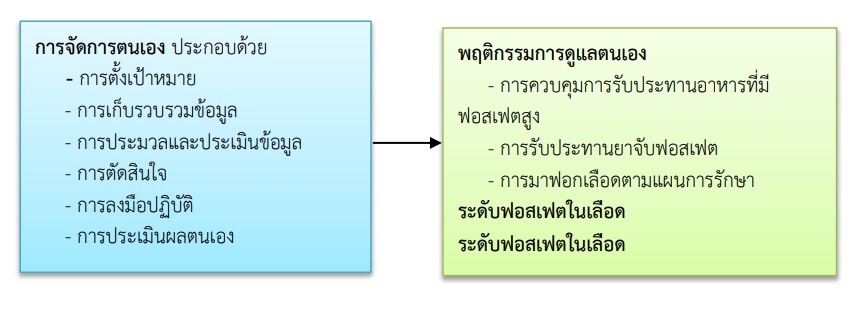ผลของการใช้แนวคิดการจัดการตนเองต่อพฤติกรรมการดูแลตนเองในการควบคุมภาวะฟอสเฟตในเลือดสูงของผู้ป่วยไตวายเรื้อรังที่ได้รับการฟอกเลือดด้วยเครื่องไตเทียม โรงพยาบาลสงขลา
คำสำคัญ:
การจัดการตนเอง, พฤติกรรมการดูแลตนเอง, โรคไตเรื้อรังที่ได้รับการฟอกเลือด, การควบคุมภาวะฟอสเฟตในเลือดสูงบทคัดย่อ
การวิจัยกึ่งทดลองแบบกลุ่มเดียว วัดก่อนและหลังการทดลอง มีวัตถุประสงค์ 1) เพื่อเปรียบเทียบพฤติกรรมการดูแลตนเองในการควบคุมภาวะฟอสเฟตในเลือดสูงของผู้ป่วยไตวายเรื้อรังที่ได้รับการฟอกเลือดด้วยเครื่องไตเทียมก่อนและหลังได้รับแนวคิดการจัดการตนเอง และ 2) เพื่อเปรียบเทียบระดับของฟอสเฟตในเลือดของผู้ป่วยไตวายเรื้อรังที่ได้รับการฟอกเลือดด้วยเครื่องไตเทียม ก่อนและหลังได้รับแนวคิดการจัดการตนเอง กลุ่มตัวอย่าง คือผู้ป่วยไตวายเรื้อรัง จำนวน 32 คน ที่ได้จากการคัดเลือกแบบเจาะจงตามคุณสมบัติที่กำหนด เครื่องมือในการทดลอง คือแผนการสอนผู้ป่วยเพื่อให้ความรู้เกี่ยวกับการจัดการตนเอง คู่มือปฏิบัติตนสำหรับผู้ป่วยเพื่อให้มีการจัดการตนเองเพื่อควบคุมภาวะฟอสเฟตในเลือดสูง เครื่องมือที่ใช้ในการเก็บรวบรวมข้อมูล ได้แก่ แบบสอบถามข้อมูลทั่วไปและภาวะสุขภาพ แบบสอบถามพฤติกรรมการดูแลตนเอง เครื่องมือที่ใช้ผ่านการตรวจสอบความถูกต้องของเนื้อหา ได้เท่ากับ .98 และทดสอบความเชื่อมั่น ได้เท่ากับ .86 วิเคราะห์ข้อมูลโดยการใช้สถิติเชิงพรรณนา และสถิติการทดสอบค่าทีแบบสัมพันธ์ ผลการวิจัยพบว่า
1. พฤติกรรมการดูแลตนเองในการควบคุมภาวะฟอสเฟตในเลือดสูงของผู้ป่วยไตวายเรื้อรังที่ได้รับการฟอกเลือดด้วยเครื่องไตเทียมภายหลังได้รับแนวคิดการจัดการตนเอง (M=3.60, SD=.67) สูงกว่าก่อนได้รับแนวคิดการจัดการตนเอง (M=3.21, SD=.94) อย่างมีนัยสำคัญทางสถิติที่ระดับ .001
2. ระดับฟอสเฟตในเลือดของผู้ป่วยไตวายเรื้อรังที่ได้รับการฟอกเลือดด้วยเครื่องไตเทียมภายหลังได้รับแนวคิดการจัดการตนเอง (M=5.13, SD=1.76) ต่ำกว่าก่อนได้รับแนวคิดการจัดการตนเอง (M=5.85, SD=1.33) อย่างมีนัยสำคัญทางสถิติที่ระดับ .01
ผลการศึกษานี้แสดงให้เห็นว่าการใช้แนวคิดการจัดการตนเองทำให้พฤติกรรมการดูแลตนเองในการควบคุมภาวะฟอสเฟตในเลือดสูงของผู้ป่วยไตวายเรื้อรังที่ได้รับการฟอกเลือดด้วยเครื่องไตเทียมดีขึ้น พยาบาลไตเทียมสามารถใช้แนวคิดการจัดการตนเองของบุคคลเพื่อส่งเสริมให้ผู้ป่วยไตวายเรื้อรังที่ฟอกเลือดด้วยเครื่องไตเทียมเกิดพฤติกรรมความร่วมมือในการควบคุมฟอสเฟต
เอกสารอ้างอิง
Block, G. A., Klasser, P. S., Lazarus, M., Ofsthun, N., Lowrie, E. G. & Chertow, G. M. (2004). Mineral Metabolism, Mortaliyt, and Morbidity in Maintenance Hemodialysis. Journal of the American Society of Nephrotogy, 15(8), 2208-2218.
Chamnan, A., Kitsripisarn, S. & Tasanarong, A. (2021). Impact of Individual and Family Self-Management Programme on Hemodialysis-Treated Patient, Adherence to Phosphorus Controal and on Their Calcium X Phosphorus Product. Thesis of master Nursing Science, Adult and Older Adult of Nursing Thammasat University. Journal of Thailand Nursing and Midwifery Council, 36(2), 50-65. (in Thai).
Chuasuwan, A. & Lumpaopong, A. (2021). THAILAND RENAL REPLACEMENT THERAPY YEAR 2020. Association of Kidney Diseases.
Creer, L. T. (2000). Self-Management of Chronic Illness. Handbook of Self-Regulation. California: Academic. 601-29.
Jintana, P., Sriyuktasuth, A., Pongthavornkamol, K. & Nata, N. (2016). Information-Motivation- Behavioral Skills Program Improved Phosphate-Binder Adherence in Patients with Chronic Hemodialysis. Journal of Nursing Science, 34(2), 92-101 (in Thai).
Kiatsunthorn, K. (2021). CKD-MBD. Academic Conference CKD Weekened 2021 Living with Kidney in Disruptive Era. 12-14 November 2021 Virtual Online Metting. Association of Kidney Diseases.
Kochaseni, P., & Jittinan, A. (2021) “Chronic Kidney Disease and Initiation of Dialysis. In Nongnuch, A., Tironthanakul,K., Srisuwan, K. & Opacharoensuk.W.”Essential in Hemodialysis (pages 1-20). Bangkok: Text and Journal Publication Co., Ltd.
Kralik, D., Koch, T., Price, K. & Howard N. (2004). Chronic Illness Self-Management: Taking Action Tocreate Order. J Clin Nurs, 13(2), 259-67.
Lins, S. M. D., Leite, J. L, Godoy, S., Tavares, J. M., Rocha, R. G. & Silva, F. V. (2018). Treatmentadherence of Chronic Kidney Disease Patients on Hemodialysis. Acta Paul Enferm, 31(1), 54-60.
Martins, M. T., Silva, L. F., Kraychete, A., Reis, D., Dias, L., Schnitman, G. et al. (2013). Potentially ทModifiable Factors Associated with Non-Adherence to Phosphate Binder Use in Patients on Hemodialysis. BMC Nephrology, 14(208), 2-10.
Opasharoenkul, W. (2014). Criteria for Hemodialysis Treatment Accreditation, Revised 2014. The Nephrology Society of Thailand: Bangkok.
Peeraphruettipong, N., Pakdevong, N. & Chotima, P. (2014). The Effectiveness of the Self- Management Program on Knowledge, Self-care Activeitices, and HbA1C in Persons with Type 2 Diabetes Mellitus: 1 Year follow=up studt. (in Thai)
Petchai, T., Mingkaeo, S., Nonthapha, Y., Kumthong, W., Homrach, P., Piyalungka, et al, (2018). The Effectiveness of Self Management on Fluid Overload Management for Chronic Kidney Disease Patients with Hemodialysis at Somdej Phranangchaosirikit Hospital. Royal Thai Navy Medical Journal, 45(1), 106-120.
Shi, Y. X., Fan, X. Y., Han, H. J., Wu, Q. X., Di, H. J., Hou, Y. H., et al (2013). Effectiveness of a Nurse-Led intensive Educational Programme on Chronic Kidney Failure Patients with Hyperphosphataemia: Randomised Controlled Trial. J Clin Nurs, 22(7-8), 1189-97.
Umbangtalad, D. & Prasongwattana, S. (2017). Effectiveness of Intensive Care Program for Patients with Type II Diabetes on Knowledge, Self-Management Behavior and Blood Sugar Levels of Diabetic Patients in PCU, Bang Pa-in District, Phra Nakhon Si Ayutthaya Province. Nursing Journal Public Health and Education, 18(1), 17-23. (in Thai)
Umenkeje, E. M., Mixon, A. S., & Cavanaugn, K. L. (2018). Phosphate-Control Adherence in Hemodialysis Patient: Current Perspectives. Patient Preference and Adherence, 12 1175-1191.
Vallée, M., Weinstein, J., Battistella, M., Papineau, R., Moseley, D. & Wong, G. (2021). Multidisciplinary Perspectives of Current Approaches and Clinical Gaps in the Management of Hyperphosphatemia. International Journal of Nephrology and Renovascular Disease, 14, 301–311.
Wagner, E. H., Brian, A. T., Davis, C., MikenHindmarsh, Schaefer J. & Bonomi, A. (2001). Improving Chronic Illness Care: Translating Evidence Into Action. Health Affairs, 20(6), 64-78.
Wongrattana, C. (2017). Techniques for Using Statistics for Research. Amorn Printing. Bangkok.

ดาวน์โหลด
เผยแพร่แล้ว
ฉบับ
ประเภทบทความ
สัญญาอนุญาต
ลิขสิทธิ์ (c) 2022 วารสารการพยาบาลและการศึกษา

อนุญาตภายใต้เงื่อนไข Creative Commons Attribution-NonCommercial-NoDerivatives 4.0 International License.





